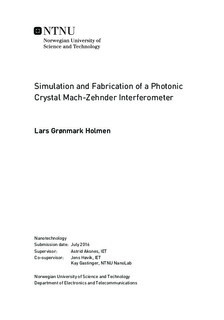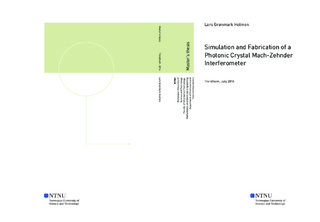| dc.description.abstract | Photonic crystals (PhC) are materials with extraordinary optical properties in terms of dispersion characteristics and light confinement, which make them a promising platform for photonic integrated circuits. This study aims at designing, simulating and fabricating a Mach-Zehnder interferometer (MZI) implemented in an air-hole silicon photonic crystal slab, with a specific application as a label-free optical biosensor.
Computer simulations are performed in both two and three dimensions using the freely available software packages MIT Photonic Bands [Johnson2001] for computation of eigenmodes in periodic dielectric media, and MIT Electromagnetic Equation Propagation [Oskooi2009] for finite-difference time-domain simulations of transmission through finite-sized devices. The transmission properties of the interferometer are investigated and optimized at the level of its discrete constituents (linear defect waveguides, 60 degree bends and Y-splitters), before the MZI is studied for use in label-free sensing of biomaterials, where biolayers added to the sensing arm of the interferometer are used to modulate the output intensity.
After studying fundamental mechanisms for optical losses in PhC waveguides, structural optimizations resulted in high and broadband transmission through complete MZIs, with 3 dB bandwidths of 99 nm and 53 nm in 2D and 3D, respectively. Addition of biolayers to the MZI sensing arm successfully resulted in modulations of the output intensity in form of sharp transmission dips caused by excitation of high-Q resonances. The simulations demonstrate a novel concept of a compact MZI with promising possibilities of working as a label-free biosensor.
Fabrication of photonic crystal structures is performed using electron beam lithography (EBL)-patterning followed by inductively coupled plasma-reactive ion etching (ICP-RIE) of silicon-on-insulator (SOI) substrates made by depositing \oxide{arg1} and amorphous silicon onto silicon wafers using plasma-enhanced chemical vapor deposition (PECVD).
The systematic optimizations of fabrication processes resulted in high-quality silicon structures, having RMS sidewall roughness < 1 nm as measured from top-view SEM images, and vertically etched sidewalls with angles from 1 to 2 degrees. With respect to hole shape, sidewall roughness and process reproducibility, these are the best results from fabrication of silicon photonic crystals achieved at NTNU. Work remains on optical characterization of fabricated devices and development of biofunctionalization processes, but the processes developed form a promising basis for future fabrication of functional SOI photonic devices. | |

